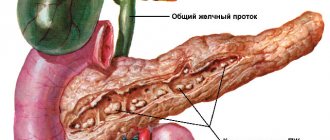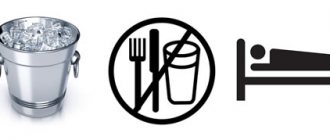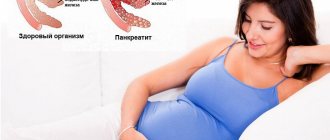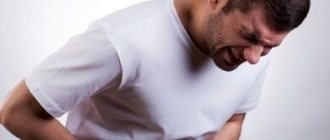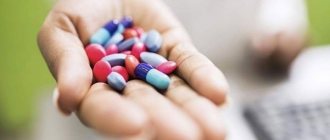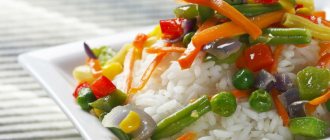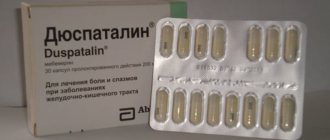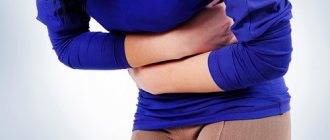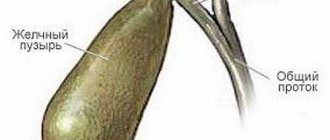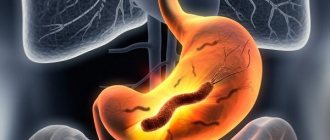About 10-15% of the population of our planet are familiar with cholecystitis, or inflammation of the gallbladder (GB), firsthand. Discomfort and nagging pain in the right hypochondrium, difficulties with digesting food and an unpleasant bitterness in the mouth - all this is a reason to undergo an examination. How to treat cholecystitis: in our review and video in this article we will analyze the most effective remedies that will definitely help you.
Trust a specialist
Basics of disease classification
Before we discuss what to drink during cholecystitis to quickly relieve pain and discomfort, let’s figure out what types of gallbladder inflammation exist. After all, the clinical form of the disease largely influences the selection of treatment tactics.
Main causes of pathology
Cholecystitis is divided into two large groups:
- Spicy:
- catarrhal – involving the mucous (superficial) membrane of the organ in the pathological process;
- phlegmonous - with diffuse purulent inflammation;
- gangrenous – with necrotic lesions of the gallbladder wall.
- chronic.
Acute cholecystitis is no joke
Important! Acute cholecystitis is treated by a surgeon in a hospital setting. Most patients are indicated for surgery - cholecystectomy. It is prohibited to treat phlegmonous and especially gangrenous forms of inflammation at home!
And yet, the overwhelming majority of patients are faced with chronic cholecystitis (CC). So, what is cholecystitis and why is it dangerous?
In more than 60% of patients, chronic disease is caused by infectious agents - Escherichia coli, streptococci, salmonella, etc.
As a result of the damaging effect on the wall of the gallbladder, a sluggish inflammatory process develops. Over time, the walls of the organ thicken, become inactive, and ulcerations and scars appear on the mucous membrane. This in turn provokes further disturbances in the outflow of bile and the formation of stones.
Note! Exacerbation of XX practically always occurs after an error in the diet - eating fatty fried foods. An attack can also be triggered by hypothermia, decreased immunity, shaking, and intense physical activity.
Symptoms of purulent cholecystitis
Purulent or phlegmonous cholecystitis is one of the most dangerous forms of pathology. If treatment is delayed or incorrect, the patient may die. This form can be recognized by its characteristic symptoms:
- pain in the stomach area, which becomes strong and intense when breathing, coughing or changing body position;
- slight bloating;
- increase in body temperature to high levels;
- slight seething in the intestines;
- nausea and vomiting.
Conservative methods of treating chronic cholecystitis
Treatment of chronic cholecystitis is usually carried out with conservative methods (but surgery may also be required).
Among its main goals:
- elimination of inflammatory changes in the wall of the gallbladder;
- prevention of complications;
- elimination of symptoms of pathology;
- improving the quality of life and rehabilitation of patients.
It is important to reduce the number of exacerbations
Important! The treatment plan is drawn up by the doctor individually for each patient. The chosen tactics are largely determined by the clinical course of the pathology (frequency and severity of exacerbations), the presence/absence of stones, and the functional state of the gallbladder.
Non-drug therapy
Before we look at what medications to take for cholecystitis, we would like to draw your attention to the fact that diet therapy remains an important method of treatment. All patients with XX should adhere to treatment table No. 5 (according to Pevzner).
Among its principles:
- Frequent and, importantly, small meals (about 5-6 times a day).
- Creating and maintaining a clear diet.
- Consume 2500-2900 kcal per day.
- Creating a menu with the optimal content of proteins, fats and carbohydrates.
- Reducing the proportion of animal fats in the diet and increasing the proportion of plant fats.
- Drink plenty of fluids (about 2 liters of clean water per day).
- The preferred heat treatment options are boiling and steaming.
We treat the body from the inside
Among the permitted products:
- lean meat (poultry, rabbit, beef, fish);
- wheat bran;
- cereals (especially millet, buckwheat);
- fermented milk products;
- vegetables and fruits.
In addition to water, it is useful to drink dried fruit compotes and rosehip decoction.
The following are excluded from the diet of patients:
- fatty, smoked dishes;
- fatty meat and offal (kidneys, brains, tongue, etc.);
- egg yolks;
- spices and seasonings;
- rich broths;
- baked goods and confectionery products;
- nuts;
- alcohol;
- carbonated drinks.
Permitted and prohibited products
Important! Patients with chronic disease are recommended to adhere to a therapeutic diet throughout their lives. This will help significantly reduce the number of exacerbations.
Drug therapy
Medicines for cholecystitis of the gallbladder are another mandatory element of therapy. It is very important that all tablets and injections are prescribed by a qualified doctor (generalist or gastroenterologist) based on the examination data obtained. Only a specialist will be able to assess the nuances of the pathology and the individual characteristics of the body.
What medications will be helpful for you?
So, what to take for cholecystitis: medications are divided into several pharmacological groups.
Table: Injections and tablets for cholecystitis of the gallbladder:
| Group | Mechanism of action | Representatives |
| Antibiotics | Elimination of bacterial infections and local inflammation | Azithromycin, Ampicillin, Amoxicillin, Ceftriaxone, Metronidazole |
| Sulfonamides | Destruction of pathogenic microorganisms in the intestines (with concomitant inflammation) | Sulfadimezin, Sulfalene |
| Antimycotics | Destruction of fungi that can rapidly multiply in the gastrointestinal tract in response to antimicrobial therapy | Nystatin, Fluconazole, Furazolidone |
| Choleretic drugs | Normalization of bile production and outflow | Allohol, Holosas, Chofitol |
| Antispasmodics | Relieving muscle spasms, eliminating pain syndrome | No-shpa, Papaverine, Trimedat, Duspatalin |
| Hepatoprotectors | Restoration of liver function, acceleration of hepatocyte regeneration | Essliver, Essentiale forte, Ursosan, Karsil, Heptral |
Antibiotics, sulfonamides and antifungals
Antibiotics for cholecystitis and liver inflammation are an important component of treatment. However, before choosing one or another drug, it is important to undergo a detailed diagnostic study, identify the causative agent of inflammation and determine its sensitivity to antimicrobial agents.
An antibiotic for cholecystitis must have specific activity against microbes colonizing on the walls of the gallbladder.
There are so many medications - which one will help?
Most often, patients are prescribed cephalosporins. They are the ones who effectively defeat cholecystitis: antibiotics have high activity and a wide spectrum of action. In case of severe exacerbation of the disease, drugs of the erythromycin group are recommended.
What tablets should pregnant women, elderly patients and children take for cholecystitis? For them, effective and absolutely safe antibiotics of the penicillin group would be an excellent option. Due to the fact that they accumulate well in bile, the therapeutic effect occurs quite quickly.
Comparative price chart for antimicrobials
Note! Any medicine for cholecystitis of the gallbladder has its contraindications. Follow the recommendations of your healthcare professional and read the instructions for use carefully.
On average, the course of antibiotic therapy for exacerbation of chronic disease is 10-14 days. If the drug is chosen correctly, already on the 2-3rd day of treatment the patient feels much better.
Sulfonamides are a replacement for antibiotics. They are prescribed for:
- the impossibility of antimicrobial therapy with “classical” agents;
- complication of chronic inflammation of the intestinal mucosa.
Antimycotics are indicated for the activation of pathogenic fungal flora in the body. This phenomenon often occurs against the background of antimicrobial therapy, so some experts consider their preventive (prophylactic) use advisable.
Fungal infection is a common complication of antibiotic therapy
Choleretic drugs
Choleretic drugs for cholecystitis are an essential component of treatment.
According to their pharmacological action, they can be divided into two large groups:
- Choleretics – drugs that enhance bile production;
- Cholekinetics are medications that help normalize the flow of bile.
Choleretics include:
- products based on ox bile - Cholenzym, Allochol;
- plant sterols – corn silk, immortelle flowers, rose hip extract;
- synthetic drugs - Nicodin, Osalmid, Cyclovalon.
Plant-based products are effective and inexpensive
Cholekinetics are another frequently prescribed drug for cholecystitis: stagnation of bile when taken is eliminated by increasing the tone of the muscles of the bile ducts and gallbladder and enhancing its contractions.
Important! Choleretic drugs are contraindicated for obstructive jaundice, acute hepatitis, and concomitant decompensated gastrointestinal diseases. How to take Allohol for cholecystitis accompanied by gallstones, check with your doctor.
Antispasmodic drugs
“How to relieve pain with cholecystitis?” - perhaps one of the most frequently asked questions from patients. Antispasmodics can help with this - a group of medications that eliminate muscle spasms and facilitate the flow of bile into the duodenum.
Most often used But spa for cholecystitis: how to take this medicine?
Standard recommendations are as follows:
- adults – 1-2 tablets (40-80 mg) × 3 times a day;
- adolescents 12-18 years old – 1 tablet (40 mg) × 2-4 times a day;
- children 6-12 years old – 1 tablet (40 mg) 1-2 times a day.
The most famous antispasmodic
Important! In case of an acute attack with severe pain, it is advisable to use antispasmodics in injection form. Your doctor will tell you how to take Noshpa by injection.
Hepatoprotectors
Hepatoprotectors are auxiliary agents designed to prevent the destruction of cell membranes of hepatocytes and stimulate their regeneration.
There are several types of such drugs:
- based on animal components;
- based on plant components;
- amino acids;
- ursodeoxycholic acid preparations;
- essential phospholipids;
- LPO (lipid peroxidation) inhibitors;
- Dietary supplements.
Algorithm for selecting an effective hepatoprotector
Other means
Additionally, the patient may be prescribed symptomatic medications:
- NSAIDs (Paracetamol, Ibuprofen) with severe intoxication syndrome;
- antiemetic drugs (Cerucal) for severe nausea;
- vitamins for general weakening of the body, etc.
Symptomatic treatment is prescribed based on patient complaints
Physiotherapy
After the exacerbation subsides, patients are advised to undergo physiotherapeutic procedures.
These include:
- UHF therapy;
- cryotherapy;
- laser therapy;
- vacuum massage;
- DMV therapy;
- carbon dioxide and radon baths;
- galvanization and electrophoresis of antispasmodics, etc.
Many procedures are carried out in specialized sanatoriums
Note! For acalculous cholecystitis with obvious signs of bile stagnation, it is useful to do a procedure such as tubage. This set of medical procedures is used to rinse (cleanse) the liver.
Traditional methods
In addition to diet, treatment with folk remedies is possible. One of the effective methods of treatment is a decoction of horseradish root.
It must be grated and filled with water, which should be 4 times more than the mass itself.
We recommend reading: Causes of cholecystitis in adults: diagnosis and treatment
It is important to close the resulting water in a container and put it in the refrigerator for at least a day, after which it can be heated, filtered and drunk before meals.
To relieve pain, you need to make a decoction of plantain and chamomile. It is better to chop the plantain leaves and combine with chamomile in equal quantities, then put on low heat and cover with a lid. The broth should boil for 5 minutes, then set aside from the stove and let it brew for a couple of hours. When pain appears in the stomach and liver, the decoction should be slightly heated and consumed undiluted, half a glass.
A remedy suitable for everyone is oatmeal or flakes. It will be very effective for chronic cholecystitis. You can make tinctures and decoctions from it. Oatmeal is poured with boiling water in large quantities and left for a couple of hours. The liquid with beneficial minerals and enveloping properties should be drunk several times a day, and especially before bed.
Another useful and tasty method of cooking is using milk. First, oatmeal is mixed with water and jelly is made from it. Milk is poured into the resulting mass and placed on the fire for a few minutes. You can take this tincture with honey, which will also be beneficial for the immune system.
Questions for the doctor
Treatment of cholecystitis and pancreatitis
Hello! I have been suffering from abdominal pain and digestive problems for several years now. Recently I finally underwent an examination, an ultrasound showed signs of chronic inflammation of the gallbladder and pancreas. Tell me, which doctor should I see? What medications for cholecystitis and pancreatitis are now considered the most effective? Thank you.
Good day! Be sure to contact a therapist or gastroenterologist with the results of the examination: specific medications for cholecystitis and pancreatitis can be selected only after an in-person examination.
In general, treatment should be carried out according to the scheme indicated in our article. Additionally, if an insufficient pancreas is diagnosed, enzyme preparations (Creon, Festal) will be prescribed. Antibiotics are also used according to indications: for pancreatitis and cholecystitis, there is often a need for their course use.
And don’t forget about the importance of diet: it accounts for up to 70-80% of the success of treatment. Be healthy!
Indications for the use of Omeprazole
I also encountered such unpleasant diseases as cholecystitis and pancreatitis. I went to the doctor, they prescribed me treatment (now I’m already taking pills, it seems to be helping). The only thing that raises questions is one drug. Is Omez prescribed for cholecystitis? I thought it was something from the stomach.
Hello! Omez, or Omeprazole, is a drug from the pharmacological group of proton pump inhibitors. Its mechanism of action is based on the suppression of H+ -K+ -PTPase. It has an antisecretory and antiulcer effect, reduces the production of hydrochloric acid in the stomach.
For chronic diseases and pancreatitis, the drug is used as an adjuvant therapy. It reduces pain and inflammation and has a general inflammatory effect. Omez is usually prescribed in a dosage of 20 mg once a day, the course of treatment is a month.
How does cholecystitis manifest?
The manifestation of symptoms depends on the form of the disease, so let’s take a closer look at how acute and chronic cholecystitis clinically manifests itself.
Symptoms of acute cholecystitis
Acute inflammation is always accompanied by severe intoxication, which causes headaches, fever, joint pain, lethargy and weakness, and sudden weight loss. Signs of inflammation of the gallbladder in the acute stage:
- paroxysmal pain in the right abdomen under the ribs. The occurrence of sharp pain is explained by obstruction of the lumen in the ducts by a clot of bile or a stone;
- weight loss, poor appetite;
- yellowness of the skin and eye sclera;
- when diagnosed at a doctor’s appointment, pain and dilation of the bile ducts are noted;
- the appearance of chills at temperatures up to 39 degrees;
- nausea and vomiting with discharge of green bile;
- frequent constipation;
- flatulence and bloating;
- The child develops irritability and aversion to fatty foods.
During exacerbations of inflammation with the formation of stones, the symptoms are severe, and dangerous complications often develop; however, treatment of the gallbladder at home is not carried out. One of these conditions can be an abscess in the liver, when an inflamed lesion with a capsule containing pus appears inside the organ.
Symptoms of cholecystitis
It is also possible to experience peritonitis, when inflammation spreads to the peritoneum, or pancreatitis with a focus of inflammation in the pancreas. Often there is infection, the development of cholangitis with inflammation of the bile excretion tract. All these symptoms imply an urgent visit to a medical institution for medical help, including treatment in a hospital.
Symptoms of chronic cholecystitis
In the chronic form of inflammation, painful spasms increase in the biliary system and gastrointestinal tract when eating food, during stressful experiences, after drinking alcohol:
Read also: What choleretic drugs are needed when the gallbladder is bent?
- nagging pain in the right hypochondrium, possibly a burning sensation in the liver area;
- pain in the stomach, in the upper part;
- irradiation to the sacrum or lower back;
- pain in the chest in the area of the heart (cholecystocardial syndrome), with an abnormal heart rhythm. The heart is affected when the source of infection in the bladder has a toxic effect on the entire body and blood flow.
Experts point to solar syndrome, which occurs when the symptoms of chronic inflammation are ignored. In this case, pain is noted near the solar plexus. Irradiation occurs in the navel, back, the intensity grows to extremely high.
General symptoms of cholecystitis
It is important to know!
78% of people with gallbladder disease suffer from liver problems! Doctors strongly recommend that patients with gallbladder diseases undergo liver cleansing at least once every six months... Read more...
For all patients there are a number of common symptoms of gallbladder cholecystitis. In most cases, there are signs of vegetative-vascular dystonia - rapid heartbeat, tachycardia, excessive sweating, headache, loss of sleep. Of the specifically biliary manifestations that the organ is inflamed, the following symptoms are often noted:
| № | Helpful information |
| 1 | belching of air that leaves an unpleasant taste |
| 2 | there is bitterness in the mouth, especially in the morning |
| 3 | flatulence and bloating |
| 4 | failure of the digestive process, manifestations of dyspepsia - vomiting and/or nausea, constipation and diarrhea |
| 5 | itchy skin due to excess bile in the blood and bile |
| 6 | reflex vomiting that occurs after consuming fatty foods or alcohol |
Patients with allergies may experience angioedema, the most life-threatening symptom in humans. Chronic cholecystitis begins to develop in children, without showing clinical symptoms. Over time, the walls of the gallbladder thicken, severe inflammation forms, which causes such vivid symptoms.
Inflammation of the biliary organ in women
Not only are women more susceptible to gallbladder inflammation than men, but they also have several additional symptoms:
- PMS syndrome, when severe stress begins before menstruation;
- a week before the critical days, severe headaches begin;
- there are mood swings;
- pastiness in the legs and arms. The patient observes slight swelling, which causes the skin to swell and become pale, resembling raw dough.
Chronic cholecystitis always varies in its manifestations depending on the form of the disease, stage and general condition of the patient. Due to the connection of the ducts with the liver, if the bladder becomes inflamed, inflammation can often be found in the liver.
Symptoms of acute cholecystitis
There are a number of signs by which, with a high degree of probability, anyone can identify acute cholecystitis, even without special medical education.
Thus, a characteristic reaction is severe pain and nausea, the urge to vomit, which occurs a short time after a meal with a large amount of fatty foods. The pharmaceutical industry produces a number of drugs, some of which are advertised daily on TV. They help relieve such symptoms quite well, but they do not affect the root causes of the disease in any way and it continues to progress.
The pain occurs because the bile ducts are blocked.
Other symptoms of acute cholecystitis include:
- high temperature, the patient is febrile,
- weight loss,
- the liver increases in size, which is clearly felt when palpating the right hypochondrium,
- bad breath.
The main symptoms of cholecystitis in men
The main manifestation of cholecystitis is pain. The pain occurs sharply, its focus is localized just below the ribs. At first, attacks of pain pass quickly enough on their own and are easily relieved with painkillers.
But as the disease develops, the condition worsens sharply, the temperature rises, nausea occurs, the patient vomits, stools are disrupted, the pulse quickens, sometimes reaching 120-130 beats per minute, and other phenomena characteristic of inflammatory processes appear. The pain goes from intermittent to constant.
Due to the fact that the normal outflow of bile is disrupted, the patient's skin, whites of the eyes and mucous membranes acquire a characteristic icteric tint.
If cholecystitis takes a chronic form, then the symptoms become less pronounced until the next exacerbation occurs.
Symptoms of cholecystitis play an important role in drawing up the clinical picture, examining and examining the patient.
Identifying symptoms includes the following methods:
- anamnesis collection. This is based on a patient interview. The doctor studies the diseases that the person previously suffered from, their nature and effect on the liver and gastrointestinal tract,
- visual inspection. Signs of pathology make themselves felt by a coated tongue, increased pain on palpation (Keur's symptom). The projection point of the gallbladder is examined,
- lab tests,
- instrumental research. Most often this is an ultrasound.
Pain with cholecystitis
The nature of the pain and its location are the same in all patients.
Discomfort and pain syndrome manifest themselves:
- on the right side of the abdomen at the lower rib,
- the area of the stomach at the xiphoid process,
- navel area.
Pain with cholecystitis can be of various types and can be sharp, burning, stabbing, etc. It intensifies significantly with palpation and tapping on the right lower rib (projection point of the gallbladder - Ker's symptom).
Symptoms of the chronic form
Has a sluggish character. Its main symptoms may not be pronounced.
Symptoms of chronic cholecystitis are:
- discomfort and heaviness in the abdomen,
- weak point of the gallbladder projection,
- yellowish skin,
- with cholecystitis, constipation is a common manifestation,
- wave-like attacks of nausea,
- bloating,
- there is a feeling of bitterness in the mouth,
- the temperature is slightly elevated,
- increased liver size.
- bad breath.
The pain is not severe or does not appear at all.
Drug treatment
Treatment of cholecystitis with medications depends on the form of the disease, the characteristics of the clinical picture and the severity of the pathological process. The following drugs are commonly used:
| Group of drugs | Name |
| Antispasmodics (relieve muscle spasms) |
|
| Painkillers (pain relief) |
|
| Antibacterial drugs (relieve infectious inflammation) |
|
| Cholekinetics (have a choleretic effect) |
|
| Cholespasmolytics |
|
| Detoxifiers |
|
Symptoms of destructive cholecystitis
The disease occurs in a phlegmonous form, and its continuation is gangrenous, which has an unfavorable outcome for the patient.
The following signs of cholecystitis are characteristic:
- tachycardia, pulse can significantly exceed 100 beats per minute even at complete rest,
- It is visually clearly noticeable that when breathing, the left and right parts of the patient’s torso move asymmetrically. The breathing itself is shallow, it is very difficult or impossible to take a deep breath, a cough appears,
- consciousness is depressed.
Causes of the disease
The cause of cholecystitis may be alcohol abuse » src=»/images/1/kak-ponyat-chto-zloupotreblenie-alkogolem-pereshlo-v-alkogolizm-2.jpg» alt=»Alcohol abuse may be the cause of cholecystitis» width=»330″ height=”250″ />
The most common cause of the disease is considered to be a bacterial infection (staphylococcus, E. coli). Slightly less often, helminthiasis, stones in the bladder and ducts, alcoholism, dyskinesia, and pregnancy can provoke cholecystitis.
In addition, inflammatory diseases of neighboring organs cause metabolic disorders, which are accompanied by bile retention. All these factors lead to the gradual development of cholecystitis.
No less important reasons for the development of the inflammatory process in the gallbladder are:
- alcohol abuse;
- heredity;
- taking certain medications;
- smoking;
- hormonal disorders;
- long fasting, dry snacks;
- poor diet, eating too fatty, spicy or salty foods;
- peritoneal injuries;
- decreased immunity;
- bowel dysfunction (frequent constipation);
- stress, emotional stress;
- congenital changes in the gallbladder;
- sedentary lifestyle;
- allergy.
Somewhat more often, cholecystitis is diagnosed in elderly patients suffering from age-related changes in the body. The development of the disease occurs very slowly, asymptomatically, often occurring in a chronic form. But sometimes the pathology can worsen, leading to quite serious consequences.
